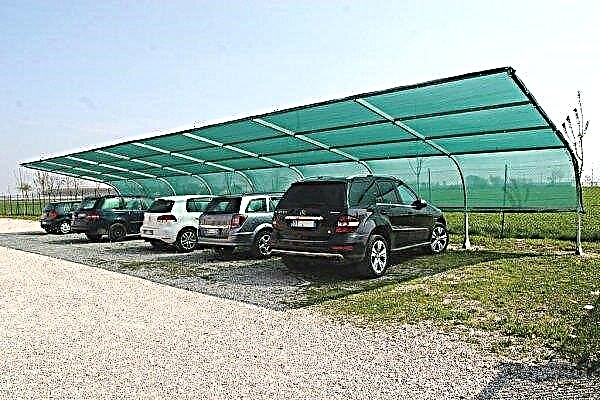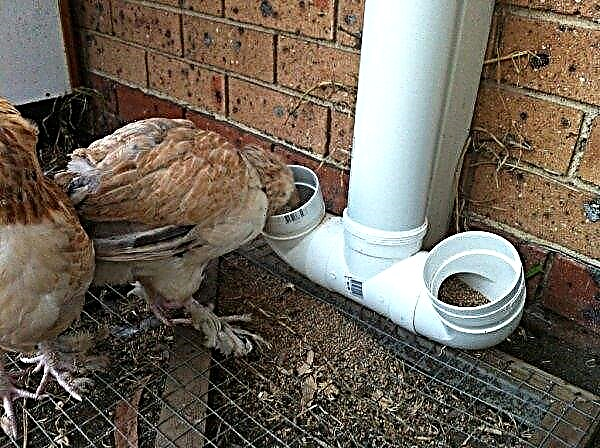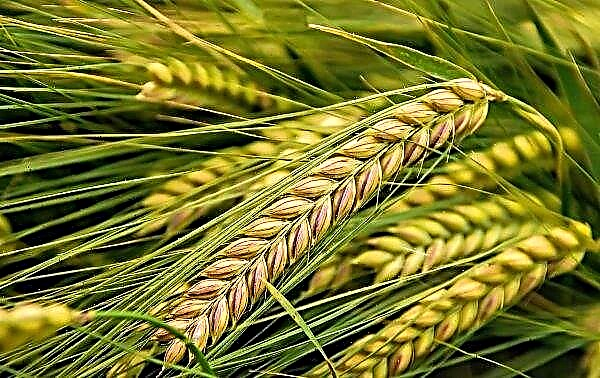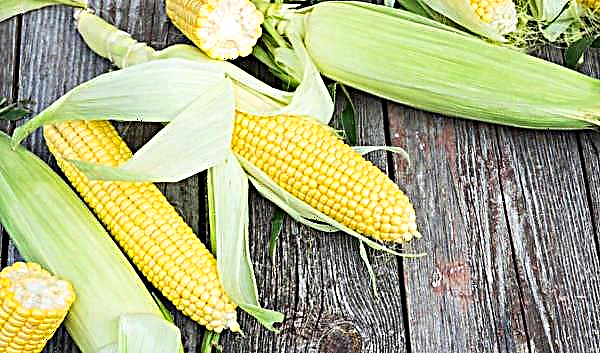Among the many different varieties of tomatoes, frost-resistant varieties are valued more than others, because they allow you to get an early crop. A representative of this variety is the well-known Snowdrop, but what exactly it has and what you should know about the features of growing tomatoes in your area - you will learn from this article.
Grade description
The tomato variety Snowdrop got into the State Register of the Russian Federation back in 2002 and since then has been often grown in various regions of the country. The painstaking work of breeders from the Biotechnika Association (St. Petersburg) has led to the emergence of frost-resistant tomatoes, which begin to ripen within 80–90 days after seedling germination. The variety belongs to semi-determinant varieties, therefore, all bushes are semi-stem, with shoot height not exceeding 130 cm. Tomato leaves are small in size, light green, with standard tomato shapes. The shoots themselves are strong and quite massive, thanks to which they withstand the large weight of ripening fruits. The bookmark of fruit brushes begins above the 7–8 leaf, after which they appear after 1–2 leaf. The flowering of tomatoes of the indicated variety is friendly, however, as is the further formation of fruits (about five fruits on each brush).
Tomato leaves are small in size, light green, with standard tomato shapes. The shoots themselves are strong and quite massive, thanks to which they withstand the large weight of ripening fruits. The bookmark of fruit brushes begins above the 7–8 leaf, after which they appear after 1–2 leaf. The flowering of tomatoes of the indicated variety is friendly, however, as is the further formation of fruits (about five fruits on each brush).
- The main advantages of cultivating this particular tomato variety are its following characteristics:
- high frost resistance, thanks to which the crop will not suffer even with small frosts;
- abundant fruiting, up to 4-5 kg of tomatoes from the bush;
- relatively early ripening of tomatoes, which is especially valuable for climatic zones with a short warm period;
- high resistance to tomato pests and typical diseases;
- excellent transportability and the possibility of long-term preservation;
- high palatability, which is largely based on good juiciness of the pulp;
- the ability to effectively grow in any type of soil;
- limited or complete lack of need for pinching;
- low demands on soil composition and climatic conditions (the variety grows equally well both at high and low temperature values).
Did you know? In Russia and neighboring countries, tomatoes are considered to be vegetables, because together with other garden crops they are grown according to a single scheme. However, from a botanical point of view, the fruits of the plant are multi-chamber syncarp berries, and some Europeans even consider them fruits, explaining this by the presence of fleshy pulp in the fruits.
Despite such an impressive list of positive characteristics of Snowdrop, one should not forget about its negative features. First of all, it is worth recalling the need for the formation of bushes and the high demands of plants for the type and amount of fertilizing. In addition, it is advisable to plant crops in regions with a cool climate, and in the southern territories choose more heat-loving plants. Cold tolerance and abundant fruiting are the main distinguishing characteristics of Snowdrop tomatoes.
Fruit characterization and yield
Under good conditions for growing tomatoes of this variety from 1 m² of plants, it is possible to collect more than 10 kg of rounded fruits with excellent flavoring properties (sometimes one bush brings more than 30 tomatoes with an average weight of 90 to 150 g).

The first ripe fruits appear already 80 days after germination, but mass harvesting will be possible only after 90 days. The color of the tomatoes is uniform, rich red. On the lower branches, the fruits are always much larger than the upper ones, but in any case, the flesh of the tomato Snowdrop is sweet and fleshy.
When cutting a vegetable, you will see three chambers with seeds that absolutely do not spoil the taste. There are no more than 5% solids in the pulp, due to which we can speak of excellent keeping quality of tomatoes and the possibility of their long transportation. The harvested crop is perfect for fresh consumption, as well as for creating winter harvestings.
Technology planting seedlings in a permanent place
Given the timing of flowering of Snowdrop tomato tomatoes (about 2 months after sowing the seeds), at the time of growing seedlings in open soil, they should be about 50–55 days old before the flowers appear on the garden bed. If the time is delayed and the seedlings begin to bloom in pots, the first brushes with the largest fruits may be lost: pollination does not occur at home, and when transplanting flowering plants, part of the flowers always crumble.
Important! In the southern regions, the seeds of the Snowdrop variety can be sown immediately in open ground, providing seedlings with a temporary film or glass shelter. With usually warm summers, spring return frosts are not terrible for this culture.
The signal for the start of transplantation is the appearance on young tomatoes of 6–7 true leaf plates. If you sowed seeds in early April, then the grown seedlings will be ready for planting in the garden in early June (typical for the central and northern regions of the Russian Federation).
After the appearance of the first sprouts, the ideal temperature for their further growth and development will be in the range + 17 ... + 21 ° C, but the tomatoes feel good even at lower rates. The picking of the planted culture is performed after the appearance of 2-3 true leaves on plants. Tomato planting scheme: 4–5 plants per 1 m² of territory (between adjacent bushes should be at least 40 cm, and between rows - 60–80 cm).

As for the process itself, it is based on standard actions:
- Selection of a suitable site (it must be well-lit, protected from wind and excessive soil moisture: no more than 70%).
- Preparation of land for planting tomatoes: autumn fertilizer of the soil with humus (2-3 kg per 1 m²), phosphorus (2 tablespoons), potash (2 tablespoons) and nitrogen (1 tablespoon) fertilizing; digging of the earth for the winter and its loosening with the advent of spring.
- Marking of beds and organization of holes for bushes.
- Removing seedlings from boxes, moving it to prepared holes and filling with additional watering.
In the next 5–7 days, it is better not to disturb young plants, allowing them to easily adapt to a new place.
Semi-determinant varieties of tomatoes also include:
Further care
After a successful transplant of seedlings, a long stage of caring for it begins, based on timely moistening of the soil, its loosening, weeding, top dressing, planting and gartering.
Watering.
When cultivating the variety Snowdrop, watering is carried out using the root method, as the top soil layer dries.  In the rainy period, you do not need to water the tomatoes, and with excessive rainfall, you will have to cover the beds with a film in order to avoid stagnation of water and decay of plants. The regularity of watering tomatoes in dry summers is once every 2 days, and hydration should be performed only in the morning, using 1.5–2 l of water for one young bush and 4–5 l for an adult plant. The best option is the water protected and heated in the sun.
In the rainy period, you do not need to water the tomatoes, and with excessive rainfall, you will have to cover the beds with a film in order to avoid stagnation of water and decay of plants. The regularity of watering tomatoes in dry summers is once every 2 days, and hydration should be performed only in the morning, using 1.5–2 l of water for one young bush and 4–5 l for an adult plant. The best option is the water protected and heated in the sun.
Weeding and cultivation.
Soil cultivation under the bushes is carried out shortly after irrigation, while the soil is still wet and supple. The places that have risen after removing the weeds need to be taken in a little, leveling the surface of the bed. The frequency of loosening of the site is 1 time in 1.5–2 weeks.
Important! The soil under the Snowdrop variety is preferably fluffed to a depth of not more than 5 cm for young plants and 9 cm under the grown bushes so as not to damage the fragile root system.
Stepson
Removal of excess lateral shoots in order to strengthen and optimally develop the main fruit-bearing stems. This procedure is performed manually, simply breaking off the shoots when they reach 5-6 cm. For the first time, the tomatoes stepchild 30 days after sowing, choosing a cloudy and cool day for this. In the future, the regularity of the procedure is once every 10 days.
Garter bushes.
Here one of two options is possible: fastening plants to trellises or to a stretched coarse mesh.  The first option is simpler and involves digging support stakes near each bush with further fixing of the plant at the very base of the fruit brush (in order not to damage the surface of the tomatoes, it is worth using soft ropes).
The first option is simpler and involves digging support stakes near each bush with further fixing of the plant at the very base of the fruit brush (in order not to damage the surface of the tomatoes, it is worth using soft ropes).
Top dressing.
The variety Snowdrop is quite sensitive to the quantity and composition of fertilizers.
Therefore, when choosing a nutritional composition and its specific dosage, several basic nuances must be taken into account:
- For the first time fertilizers are applied to the soil 14 days after the emergence of young sprouts, for which 1 kg of mullein and 15 g of superphosphate are diluted in 10 liters of warm water, then the bushes are added with the finished mixture (0.5 liter per bush).
- Second time tomatoes are fertilized two weeks after the previous top dressing using a mixture of superphosphate (20 g) and potassium chloride (15 g) diluted in 10 liters of water (the rate of use is the same as in the previous case: 0.5 liter for each plant) .
- Third time tomatoes are fed after 20 days, and this time for each bush you can pour 1 liter of a weak solution of mullein, and if the leaves began to turn yellow on the plants, then 15 g of ammonium nitrate should be added to the prepared mixture.
- Fourth feeding often coincides with the beginning of fruiting of plants, and in this case, a mixture with 20 g of superphosphate and 70 g of wood ash is used as a nutritional composition.
Did you know? In addition to cultivated tomato varieties, there are also wild varieties with a very interesting appearance. For example, in South America grow tomatoes weighing no more than 1.5 g and very sweet flesh.
On depleted soils, pre-planting fertilizer, with a handful of compost in each planting hole, will be equally important for the development of the crop. So that the fertilizer does not burn the delicate roots, it is worth mixing it with the soil first.
Disease and Pest Prevention
The Snowdrop variety is characterized by excellent resistance to typical tomato ailments of fungal origin, but in rare cases, plants still suffer from root rot. You can cope with the problem and prevent its spread by observing the requirements for watering, loosening the soil and mulching it. True, it is more reasonable to remove heavily damaged plants from the garden, preventing the spread of rot.
No less dangerous for the summer resident will be tomato ailments associated with ignoring the rules of crop rotation and proper care. In this case, we are talking about late blight, brown spotting, brown and vertex rot. At the first symptoms of each of them (for example, spots on leaves, wilting or drying of leaf plates), it is worth using special fungicidal preparations: for example, Fitosporin-M, Integral, HOM, Barrier, Megafol, Bayleton.

The implementation of preventive recommendations will help to supplement their action and prevent the re-emergence of diseases: ventilation of greenhouse crops, moderate hydration of the substrate, alternation of crops in the selected area during further planting. Of the pests, the melon aphids and thrips will be the most dangerous for Tomato Snowdrop tomatoes, in the fight against which the Zubr insecticidal preparation is often used (the method of application and dosage are always indicated on the package).
In open soil, tomatoes can also be damaged by slugs, and to prevent this from happening, it is important to regularly clean weeds and tops of dried specimens. You can also sprinkle soil under tomatoes with sand or lime, after removing the already present inhabitants from the plants. Sometimes tomato stands are interested in greenhouse whiteflies, which hide under the leaves and contribute to their withering. In this case, the well-known Confidor will help to get rid of the problem, which, after preparation of the working mixture, is sprayed on the plant.
Important! It is advisable to use any chemical substance before the fruit ripens, but if you have no choice, then try not to eat the fruit for the next two to three weeks after processing.
Harvesting and storage
When planting seedlings in early June, the ripening of the fruits of the Snowdrop variety is observed already in late July or early August. Pinkish-red specimens are suitable for collection, which must be removed from the bush with the stalks, especially if you plan to plant the crop for long-term storage. It will not be possible to collect all the fruits at once, since they ripen in stages, within 3-4 weeks.

An ideal place for short-term storage of harvested tomatoes (no longer than 4–5 days) is a regular kitchen table, protected from direct sunlight. A refrigerator for storing such tomatoes is not suitable: in a few days the vegetables will lose their aroma and taste. In addition, fruits laid for storage should not be washed, unless you intend to use the crop in the very near future. Simply wipe the tomatoes with a soft cloth, eliminating soil residues and other dirt.
If you want to keep fresh tomatoes as long as possible, you will have to place them in the cellar, having previously laid them in rows in wooden boxes (the bottom of such boxes should be lined with craft or parchment paper, and then every new layer of vegetables should be overlaid with it). The lid of the container should not press on the fruits, excluding the possible damage to tomatoes. If the tomatoes already have rotten or damaged places, then such fruits should immediately be removed from the general box.
Brown tomatoes collected at an early stage of maturity can be stored in a ventilated cellar for about two months, the main thing is to carefully put them in boxes. In the case of laying green tomatoes for storage (at the stage of milk maturity), their shelf life will be 4-6 months, however, for this, the temperature in the room with vegetables should be kept at + 2 ... + 3 ° C, and the humidity level should not exceed 60% . 3-4 days before consuming the harvest, tomatoes should be brought into a warm room and left to ripen in a well-lit place. During this time, vegetables will change color and become an excellent ingredient for different dishes.
The Snowdrop variety is a good option for those who do not like too picky vegetables that require constant attention. However, to get the maximum yield, you still have to take into account the above recommendations for planting and further care for the described tomatoes. Properly organizing your activities, it will not be difficult to do this.












